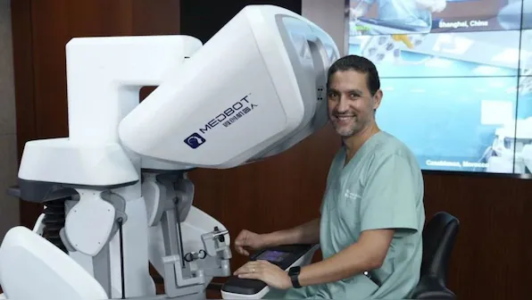A Muslim Doctor Dr Youness Ahallal becomes the world’s first to perform intercontinental robotic surgery.
A French doctor in China successfully performed prostate cancer surgery on a patient in Morocco, located 12,000 kilometres away. Using a Chinese-made robot, the doctor performed the world’s longest remote surgery in just two hours

Dr Youness Ahallal completed the surgery in under two hours. Image courtesy: X/@ChineseCGMumb
In a groundbreaking moment for medicine, Dr. Youness Ahallal, a French-Moroccan surgeon, achieved a milestone by performing the world’s first intercontinental robotic prostatectomy. On November 16, Sitting in China, a French doctor performed prostate cancer surgery on a patient in Morocco, 12,000 kilometres away with Dr. Ahallal stationed in Shanghai and his patient in Casablanca, Morocco.
Dr Youness Ahallal completed the surgery in under two hours.
But how did he pull off this groundbreaking procedure?
The doctor used a Chinese-made robot to carry out the surgery.
On November 16, Youness Ahallal completed the surgery in under two hours, with a one-way latency of just over 100 milliseconds.
This intercontinental surgery has set a record for the world’s longest remote surgery ever performed, with a round-trip transmission distance surpassing 30,000 kilometres, according to Xinhua News Agency.
Using the state-of-the-art Toumai Robot, the procedure showcased the future of telesurgery—minimally invasive, precise, and unaffected by geographical barriers. This record-breaking feat not only demonstrated the power of advanced surgical robotics but also the potential of global medical collaboration.

The Future of Telesurgery
This historic operation signifies the dawn of a new era where geographical barriers no longer hinder access to specialized surgical care. Powered by advancements in robotics and connectivity, telesurgery enables expert surgeons to operate on patients anywhere in the world.
How Does Telesurgery Work?
- Surgical Robots: Equipped with articulated arms, robots like Toumai or the Da Vinci system execute precise movements controlled remotely by the surgeon.
- Surgeon Console: The surgeon uses a console to view high-definition 3D imagery and operate the robot with manual controls.
- High-Speed Connectivity: Reliable, low-latency internet is critical to ensure real-time responsiveness, with future 6G technology expected to enhance performance further.
- Real-Time Communication: Continuous visualization and monitoring platforms allow seamless coordination between the surgeon and the patient’s team.
Source:Firstpost
Read more positive Muslim News
Follow our Ilm Daily whatsapp channel or our Facebook channel
Discover more from Islam Hashtag
Subscribe to get the latest posts sent to your email.




